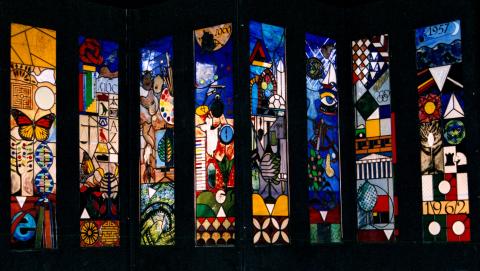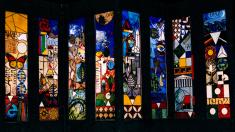Rob Garrett
Curator
Dugald Page
Stained glass windows at Westlake
The stained glass window has traditional connections to commemoration and memorial. It is an art form of illustration, instruction and enlightenment. It is usually tasked with saying something, or many things – important things – it is not enough to be good looking.
Dugald Page’s eight stained glass windows in the new school hall at Westlake Boys High School on Auckland’s North Shore are no exception. Page, who headed the art department at the school throughout the 1960s before moving on to stints at North Shore and Auckland colleges of education, was recently commissioned to design the windows to mark the 50th anniversary of the founding of the school in 1957.
It seems fitting that Page has been asked back for this, but his legacy to the school is also in the lives touched, especially at Westlake in the 1960s where art was vibrant alongside rugby and rowing. Those who sprang from these years include London architect Julian Feary, artists Bruce Barber and Ron Left, Mambo designer Chris O’Doherty (also of Mental as Anything fame), Ralph Davies (film) and Peter McCully (visual effects).
The challenge when designing stained glass windows as a commemoration of 50 years of a high school is tough, no matter how open the brief. There is no unifying faith; no character-driven narrative; and no beginning, middle and end in the dramatic sense. There is only bewildering complexity; layer upon layer of possibility. Page has tackled this complexity head on by establishing unifying strands that weave through all eight panels: prismatic colour, seasonal change and the metaphor of metamorphosis. Stitched into these strands is a palimpsest of iconic symbols of science and technology, sport, the Pacific, discovery, historic events, literature and the arts.
The rainbow colour themes and the metamorphosis of the Monarch butterfly as a metaphor for the growth and development of adolescent boys may hark back to the utopian repertoire of late modernist art and design. But the icons scattered across the panes resonate with the contemporary click-and-drag world of computer screen imagery. These are aesthetic devises which successfully span the school’s 50 years of cultural change.
Previously published in Art News New Zealand, Winter 2008, p21.

